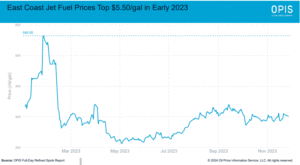Jet Fuel Demand Continues to Recover in 2024 as Sustainable Aviation Fuel Use Increases
US jet fuel demand in 2023 continued to recover from the COVID-19 pandemic, and the commercial airline industry began to move toward increased use of sustainable aviation fuel production to fulfill its net-zero carbon pledges.
 Jet fuel demand in 2023 peaked at 1.942 million b/d in June, followed closely by 1.917 million b/d in early May, the Energy Information Administration estimated.
Jet fuel demand in 2023 peaked at 1.942 million b/d in June, followed closely by 1.917 million b/d in early May, the Energy Information Administration estimated.
Those were the only two weeks of 2023 when jet fuel consumption reached the 1.9 million b/d mark, up from just one week when that number was reached or exceeded in 2022. In 2021 and 2020, jet fuel demand never reached that level.
That 1.9 million b/d-plus mark was much more common in the years leading up to the pandemic, with two weeks over that level and one week over 2 million b/d in late November and early December 2019.
Travel Expected to Continue to Increase
Demand is expected to continue to rise in 2024 as more travelers return. On the Sunday after Thanksgiving, the Transportation Security Administration reported more than 2.9 million passengers screened – a post-pandemic high.
The International Air Transport Association, which represents about 320 airlines responsible for 83% of global air traffic, has predicted the average cost of jet fuel in 2024 to be roughly $2.7095/gal. That’s up from the $2.6643/gal average it forecast for 2023.
Volatility in US Jet Fuel Market
US jet fuel prices in 2023 were volatile, particularly in the New York market, which experienced periodic supply issues.
 Jet fuel in the New York Harbor market from mid-January to mid-February was priced at a more than $2 premium to the front-month NYMEX ULSD contract. Spot market prices over that period rose above $5/gal for seven straight days and peaked at $5.6465/gal on Jan. 26 – the highest price of any US market in 2023.
Jet fuel in the New York Harbor market from mid-January to mid-February was priced at a more than $2 premium to the front-month NYMEX ULSD contract. Spot market prices over that period rose above $5/gal for seven straight days and peaked at $5.6465/gal on Jan. 26 – the highest price of any US market in 2023.
The spikes in New York prices came as stocks fell below 8,000 bbl, a level reached only 15 times since the start of 2019.
The early 2023 prices were similar to those seen in 2022, when New York area jet fuel prices topped $7/gal, a record high for the US.
While New York Harbor saw the biggest spikes of the year, other markets also saw price jumps in 2023. Midwest jet fuel early in 2023 was priced at $0.90 to $1 over futures, leaving the outright price at more than $4/gal for nearly two weeks in January. Jet fuel premiums to the NYMEX in Los Angeles rose to more than 50cts several times, with the spot price peaking at more than $4/gal in mid-September.
Those spikes, however, were short-lived, and the markets soon returned to more normal pricing patterns. From January to mid-December, OPIS jet fuel spot prices averaged $2.8277/gal across the five major jet fuel markets (New York, Gulf Coast, Group 3, Chicago and Los Angeles).
IATA expects global jet fuel demand to reach about 99 billion gal in 2024, or roughly 6.46 million gal/day. The International Energy Agency’s 2024 forecast is a bit higher at 7.19 million gal/day.
More airlines began using SAF in 2023 as a way to begin to meet their carbon-reduction targets, and production of the fuel is increasing, though it remains a fraction of conventional jet fuel output.
IATA estimated that SAF volumes in 2023 rose to 600 million liters globally, nearly twice the level in 2022, and accounted for 3% of total renewable fuel production. The industry group expects that to rise to nearly 1.9 billion liters in 2024, meeting about 0.53% of the aviation industry’s total demand. The increased use of SAF is predicted to raise the airline industry’s fuel costs next year by $2.4 billion, according to IATA.
Carbon Offsetting and Reduction Scheme for International Aviation
Most airlines have entered into the Carbon Offsetting and Reduction Scheme for International Aviation, or CORSIA agreement, which requires them to offset CO2 emissions above 2020 levels, and a number of carriers are testing blends of conventional jet fuel and SAF to help offset carbon emissions.
The production of SAF is expected to grow in terms of the piece of overall renewable fuels production as well. IATA expects SAF production to rise to 6% of total renewable fuel output in 2024.
